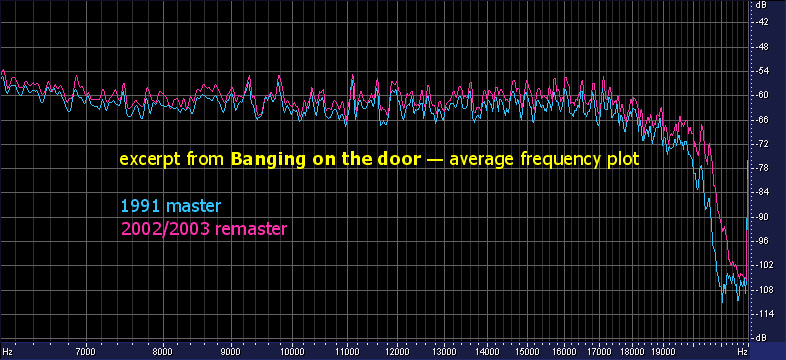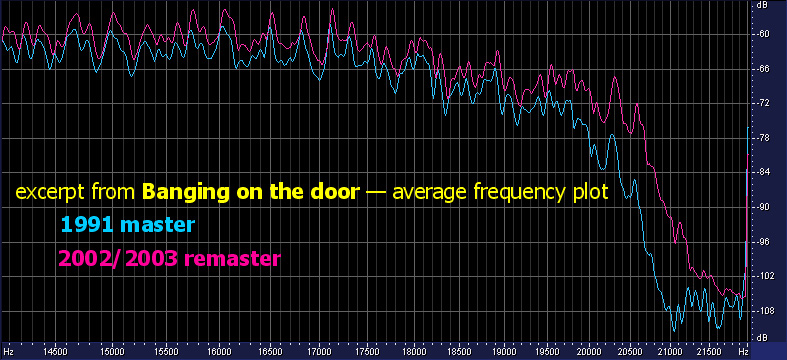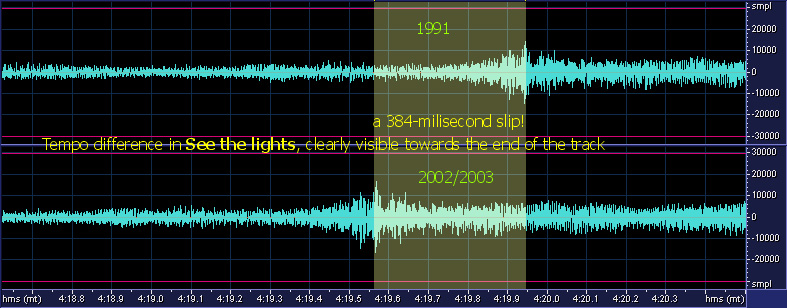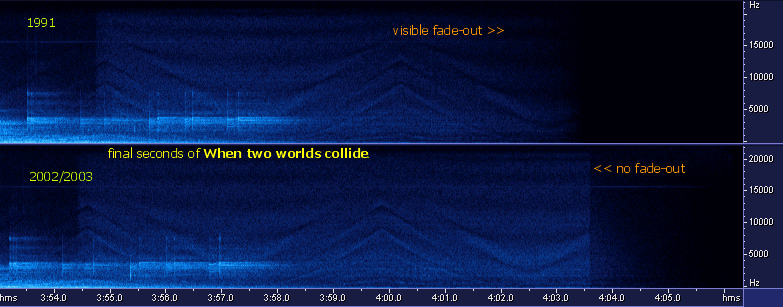
| Dream Giver - Simple Minds Online Unofficially | Remasters |
This text is a result of a comparison I made between the original CD version of Simple Minds' Real Life (1991) and its remastered jewel-case edition (2003). I am not a professional sound engineer. This is just my hobby, so please do not expect this paper to be one-hundred-percent accurate.
Upon playing the new edition on my stereo, the first thing I noticed was that high frequency sounds seemed to play louder than on the old CD. This made me compare both editions in a digital sound editor. What I found is that high frequency sounds, indeed, play louder, but only from c. 20kHz above (Audio CDs have a purely theoretical bandwidth of 0Hz-22.05kHz). Apparently, Simon Heyworth, the remastering engineer for the whole remastered series, had transferred the original digital master tapes to a higher resolution format, most probably 24-bit PCM at 96kHz (although values up to 32 bits and 192kHz are also achievable in digital sound processing; on Audio CD's the format is 16-bit PCM at 44.1kHz). [A note for all the DSD & SACD trainspotters: Even though Real Life has apparently also been made ready for a Super Audio CD release, the sound processing most probably must have been done in the old 24-bit Pulse Code Modulation format (PCM), since the Direct Stream Digital (1-bit) format (DSD) used in SACD's apparently does not allow for any processing, such as EQ or amplification. In order to apply any effects to DSD data, the data must be converted into PCM, and reconverted into DSD afterwards. At least, this is how it was like a few years ago. Perhaps, Heyworth had some newer sound machine that could process music directly in DSD. Who knows?] Anyway, the very fact of the original PCM tapes having been translated into another digital format for this release of Real Life might be a factor for the high frequencies playing louder. I suspect the only thing Heyworth himself did to the music was putting it through a hard limiter, so that it all plays a bit louder than on the original CD. This itself does not account for the high frequency sounds playing louder, but please be patient and wait till the mystery is revealed. The difference in average sound volume is 1dB to 2dB, depending on the track, and it is barely audible. Peak levels for the material are roughly the same (0dB or slightly below). In other words, the sound in the new edition is slightly compressed, but this was done in a rather delicate manner, so one will not find the sound muffled or audibly distorted. You can see the difference below.




Basically, THIS is why the new edition is recognised as sounding 'different.' I suspect the reason for this phenomenon to be quite simple. When converting from 24-bit PCM to 16-bit PCM resolution or from DSD to 16-bit PCM for Audio CD, sound engineers often use so-called dithering, together with so-called noise shaping, to make quiet details of the music kind of come up and be more audible. Mathematically speaking, this is a rather primitive task. Instead of taking just the 16 most significant bits from a 24-bit sample or a DSD stream that counts as 24-bit-like PCM, the computer takes, for example, 15 bits straight off the 24-bit number, and then decides upon the value of the 16th bit by looking at what are the remaining bits in the 24-bit input. The machine also takes into consideration what were the less significant bits in a number of previous samples, so that it can make some predictions as to how to treat this region of the next few samples to come. Noise shaping cares for making quiet details play louder, too. By applying special noise curves during the conversion, the machine distorts the sound, but in a way that is audibly pleasant, so to speak. The signal-to-noise ratio is usually lost by some 6dB, but only in the highest frequencies. The loss becomes smaller while going down the frequency scale. Anyway, the nature of both processes makes audible some details that would otherwise be lost below the 16-bit resolution. (In 16-bit PCM digital audio the dynamic range is c. 96dB, where 0dB is the maximum level and -96dB is the noise floor; the numbers are a matter of convention, as one could set the range anywhere, e.g. +10dB to -86dB if needed. 24-bit PCM audio has a theoretical range of c. 144dB; each next bit expands the range by c. 6dB; in theory, humans recognise a range of 0dB-130dB, above which life threat arises; Direct Stream Digital is said to have a range of c.120dB mainly because there are no analogue-to-digital converters widely available that would have a noise floor of their own below -120dB; in theory, DSD could easily have a range of 144dB depending on how one calculates conversion rates for PCM; learn more on DSD in audiophile magazines out there.) Dithering and noise shaping are sonic cheating in a way, but the effects are usually quite nice to listen to. Both processes affect higher frequencies more than lower ones, thus the visible and audible difference above the 20kHz boundary for CD Digital Audio, but not below. I suspect both dithering and noise shaping were applied to the new master copy of Real Life.
A strange thing connected with the new edition of Real Life is that virtually all the tracks play faster than on the original album. Shocking as it may be in the case of a digitally recorded album, this is fairly possible. If one assumes that Heyworth did all of the sound processing at 24-bit/96kHz material, then the problem may lie in the sample converter used first to sample the 44.1kHz original up, and then to sample it all down (plus any converter used for DSD-PCM translation). One does not have to be a mathematician to see that 44,100 is not a divisor of 96,000 or 192,000 (although it IS a divisor of DSD's 2,822,400 Hz sampling frequency). The 96kHz format is now widely used for any digital sound processing, because sound mastered at this frequency can be used on DVD-Audio and, after a 96-to-48kHz conversion, on DVD-Video as well. It may even easily be sampled down to 32kHz, the sampling frequency for digital broadcasting or long-play DAT recording, and may be translated into DSD for Super Audio CD's. Alas, the sampling frequency used on Audio CDs (44.1kHz) is the odd one in the set. Apparently, the machine that did all the conversion had not been programmed well enough to calculate the samples and it changed the tempo. You can see this effect below.

Apparently, some tracks have their beginnings or endings restored. Take a look at When Two Worlds Collide below. This is a spectral view of the final seconds of the track. Above is the 1991 original, below the remaster. The two are a bit unsynchronised due to the difference in tempo and in the total track time, but you can clearly see that the original is faded-out between 4:03 and 4:04 (the time reference is for the remaster), while the remaster has a sudden drop in loudness at 4:03.6. The shades of blue right to the drop show that there is some sound (including noise) fading out towards the end of the track. The respective area in the original master is by far darker, i.e. quieter.

The original CD had When Two Worlds Collide clock at 4:02. The new one has the track 4:06 long. Related to this slip in timing is the fact that the gap between Rivers Of Ice and When Two Worlds Collide is now longer. On the original CD the two tracks were cross-faded so that Rivers of ice never actually ended, but went straight into the next track. The new version of Real Life has these tracks separated. The original had the gap between two particular notes in both tracks 9.7 seconds long. The new CD has the gap between the same notes 12.7 seconds long. The 3 seconds that were restored for the new edition consist of a full fade-out in Rivers Of Ice followed by a full fade-in towards When Two Worlds Collide. The two tracks are now really separated, although there is no gap between them. Interestingly enough, the cross-fades between Ghostrider and Banging On The Door or between See The Lights and Let There Be Love are still there! However, the gap between two notes in See The Lights and Let There Be Love is 6.5 seconds on the 1991 CD, and 6.0 seconds on the 2003 CD. This cannot be accounted for by the difference in tempo, especially since Let There Be Love is put in a different version (see next paragraph). In the case of Ghostrider and Banging On The Door, however, the gap seems to be the same for both CDs. Still, the title tracks plays for some 1.6 seconds longer on the new CD before See The Lights starts. Two notes between Woman and Stand By Love were separated by 3.1 seconds on the original CD, but are now 4.3 seconds away. Taking into account such differences in timing between the tracks, it is no surprise that while the original CD clocked at exact 52:17, the new one is 52:37 and 28 frames long (there are 75 frames per second on Audio CDs, even on Empires and Dance :-) ). Some ten seconds are gained through the replacement of Let There Be Love, others through re-linking the tracks.
Finally, as I already mentioned, the new edition plays a different version of Let There Be Love than the original one did. To my ears, this one is the extended album mix, previously put on The Best Of Simple Minds double CD. It clocks at 5:09 instead of 4:57. Personally, I like the extended version, but in the light of Virgin trying to make the remastered edition resemble the original album as much as possible, it seems something fishy is going on. Perhaps, they will put alternative versions into other Simple Minds albums in the future. I would not mind having some 12" mixes replace the album ones on New Gold Dream (81-82-83-84)...